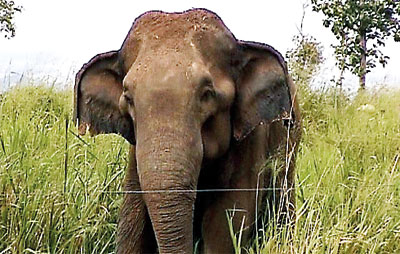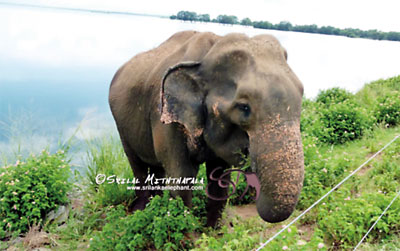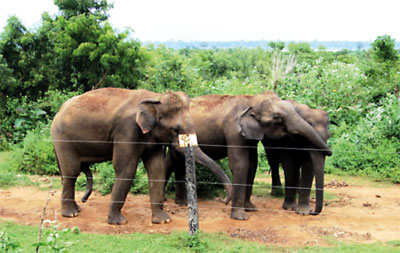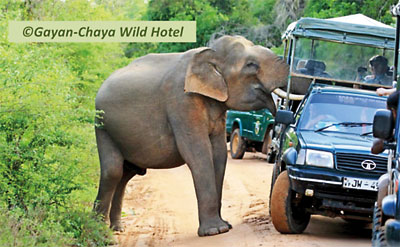Rambo the elephant swims for his snacks
I first set eyes on Rambo in the early 1990’s, when I started visiting the UdaWalawe National Park. He was a young male elephant with a very calm demeanour. He had a unique identifiable feature – his right ear was torn in several places towards the edge. He must have been around 20-25 years at that time and was just beginning to show the characteristic pigmentation of mature elephants, along the front of his trunk and ears.

Identifiable by his torn right ear, Rambo (left and below) has spent over 20 years soliciting food through the electric fence at the Uda Walawe National Park
Subsequently, Rambo discovered that coming up to the electric fence along the Thanamalwila road, and soliciting food from passers-by, was a very rewarding exercise. He was in fact one of the first elephants who started this habit of coming up to the electric fence. Many passing vehicles would stop and feed him juicy ‘tit bits’ such as watermelon, bananas and sugar cane. He always had a healthy respect for the electric fence, and never ever did try to break out. (The fence is really a psychological barrier because a full grown elephant can easily knock over the fence, especially during daytime when there is no electric current powering it).
As time went by, many other elephants ‘learnt’ this behaviour from Rambo. Being intelligent animals, this type of ‘copying’ behaviour is quite prevalent in elephants. A few years back, there were some 18 or more ‘regulars’ along the Thanamalwila road electric fence. It was always the males who loitered around, since females in herds are wary of taking such risks.
I did some casual, visual observations during this time, and found that there were about 10-12 adult males, including Rambo and the rest were adolescent males who were ‘learning the ropes’. There was very strict territorial and hierarchical behaviour that was evident. The adults had carved out their own stretches of the fence, which they patrolled, while a few of them had adolescent ‘apprentices’ tagging along behind them.
Although, I do not condone feeding these elephants, one day I bought some bananas to undertake an experiment, to check out their behaviour. The males were very protective of their ‘territory’, grabbing all the bananas being thrown into their domain, while the adolescents were forced to wait patiently behind the adults, who always had first pick. Try as much as I did, I could not feed one adolescent directly, since the adults would immediately chase it away. However, one or two sharp young fellows did manage to sneak in and get a morsel or two.

Sri Lanka’s foremost elephant researcher Dr. Prithiviraj Fernando told me that, if the elephants were really looking for food, they would have breached the electric fence long ago. His assessment was that they had enough to eat inside the park, and came for their ‘dessert’ at the electric fence! So perhaps the elephants knew they were on to a good thing and were very careful to maintain the status quo, without breaking down the fence.
There were many debates and controversies about this activity, and there were even some suggestions that if it were properly controlled, this would be a good tourist attraction. However, all this changed about a year ago, when the wildlife authorities realised that they could not properly enforce the no-feeding rule along the Thanamalwila roadside, and erected a second electric fence behind the existing one. A large amount of money was spent on this second deterrent barrier last year, which extends from the end of the reservoir bund, right up to the corner of the park boundary on the Thanamalwila road around the 25th km post. This has proven to be quite successful, and today there are no elephants along this stretch of the road.
However, the authorities had not bargained for Rambo. Unable to indulge in his favourite pastime, he began swimming across the edge of the reservoir and getting on to the steep embankment along the reservoir bund, to access the roadway and to solicit food from vehicles passing by.
Now Rambo continues to patrol this stretch of the bund. While this is quite an amusing and intriguing sight, there is some concern that Rambo is getting too dependent on this type of food. I saw him last month and he seems to be quite content to stay along the bund, eating whatever little vegetation is there and looking out for the additional favourite ‘tit bit’. The villagers told me that he more or less spends most of his time on the bund, which means that he may not be getting adequate nutrition from anywhere else. In fact, a closer look at Rambo revealed that his body condition was not that great.

Adult elephants used to patrol stretches of the fence, occasionally fending off adolescent ‘apprentices’ tagging along behind them
No doubt, he is advancing in age (he would be about 40-45 years now), but I still feel that the deterioration could be because he is not getting enough proper food. The wildlife authorities have tried on several occasions to chase him back into the park, by lighting elephant deterrent fire crackers (aliwedi) but apparently he swims back across after the authorities have left.
This is another case in point, where it is important that we need to have a proper system in place for the management of our wildlife resources. Here is a healthy male elephant, which is slowly beginning to step out of bounds, and who may soon turn into a problem. He needs to be ‘managed’.
Elephants are very intelligent animals and they learn certain behaviour quite easily. That is why even a mature wild elephant, which is captured, can still be tamed. So, using a proper ‘carrot and stick’ approach, in a carefully concerted manner, it should be possible to ‘teach’ Rambo that he should not be indulging in this type of activity.
This is very similar to the situation in the Yala National Park, with its ‘mischievous’ tusker Gemunu, who has got used to waylaying vehicles to rummage through them, looking for food. Like Rambo, this is also an exciting attraction no doubt, but at the same time, it is a potentially dangerous situation. The authorities need to therefore make a proper effort to ‘dissuade’ Gemunu by negative reinforcement that he should refrain from raiding vehicles.

At the Yala National Park ‘mischievous’ tusker Gemunu waylays vehicles in order to rummage through them, looking for food
Unfortunately the Department of Wildlife and Conservation (DWC), leave aside being able to manage and develop Sri Lanka’s wildlife resources, is unable to even maintain the minimum standards in the wildlife parks today.
Yala is virtually a lost cause now, with severe over-visitation, a mass free-for-all, with no adherence to any park rules, causing great damage to the environment and distress to the animals.
Uda Walawe is being overrun by lantana, with the whole terrain and vegetation undergoing radical change, affecting elephant migrating patterns.
Hence, very soon, Sri Lanka may lose most of its wonderful natural wildlife resources.
Follow @timesonlinelk
comments powered by Disqus


